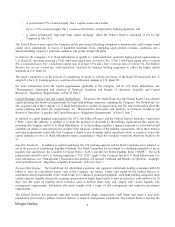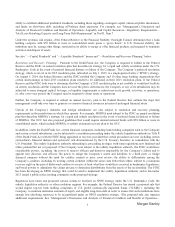Morgan Stanley 2015 Annual Report Download - page 20
Download and view the complete annual report
Please find page 20 of the 2015 Morgan Stanley annual report below. You can navigate through the pages in the report by either clicking on the pages listed below, or by using the keyword search tool below to find specific information within the annual report.
Holding large and concentrated positions may expose us to losses.
Concentration of risk may reduce revenues or result in losses in our market-making, investing, block trading, underwriting
and lending businesses in the event of unfavorable market movements. We commit substantial amounts of capital to these
businesses, which often results in our taking large positions in the securities of, or making large loans to, a particular issuer
or issuers in a particular industry, country or region.
Credit Risk.
Credit risk refers to the risk of loss arising when a borrower, counterparty or issuer does not meet its financial obligations to
us. For more information on how we monitor and manage credit risk, see “Quantitative and Qualitative Disclosures about
Market Risk—Risk Management—Credit Risk” in Part II, Item 7A.
We are exposed to the risk that third parties that are indebted to us will not perform their obligations.
We incur significant credit risk exposure through our Institutional Securities business segment. This risk may arise from a
variety of business activities, including but not limited to extending credit to clients through various loans and lending
commitments; providing short or long-term funding that is secured by physical or financial collateral whose value may at
times be insufficient to fully cover the loan repayment amount; entering into swap or other derivative contracts under which
counterparties have obligations to make payments to us; posting margin and/or collateral and other commitments to clearing
houses, clearing agencies, exchanges, banks, securities firms and other financial counterparties; and investing and trading in
securities and loan pools whereby the value of these assets may fluctuate based on realized or expected defaults on the
underlying obligations or loans.
We also incur credit risk in our Wealth Management business segment lending to mainly individual investors, including, but
not limited to, margin and securities-based loans collateralized by securities, residential mortgage loans and home equity
lines of credit.
While we believe current valuations and reserves adequately address our perceived levels of risk, adverse economic
conditions may negatively impact our clients and our current credit exposures. In addition, as a clearing member of several
central counterparties, we finance our customer positions and we could be held responsible for the defaults or misconduct of
our customers. Although we regularly review our credit exposures, default risk may arise from events or circumstances that
are difficult to detect or foresee.
A default by a large financial institution could adversely affect financial markets.
The commercial soundness of many financial institutions may be closely interrelated as a result of credit, trading, clearing or
other relationships between the institutions. For example, increased centralization of trading activities through particular
clearing houses, central agents or exchanges as required by provisions of the Dodd-Frank Act may increase our concentration
of risk with respect to these entities. As a result, concerns about, or a default or threatened default by, one institution could
lead to significant market-wide liquidity and credit problems, losses or defaults by other institutions. This is sometimes
referred to as “systemic risk” and may adversely affect financial intermediaries, such as clearing agencies, clearing houses,
banks, securities firms and exchanges, with which we interact with on a daily basis, and therefore could adversely affect us.
See also “Systemic Risk Regime” under “Business—Supervision and Regulation—Financial Holding Company” in Part I,
Item 1.
Operational Risk.
Operational risk refers to the risk of loss, or of damage to our reputation, resulting from inadequate or failed processes,
people and systems or from external events (e.g., fraud, theft, legal and compliance risks, cyber attacks or damage to physical
assets). We may incur operational risk across the full scope of our business activities, including revenue-generating activities
(e.g., sales and trading) and support and control groups (e.g., information technology and trade processing). Legal, regulatory
and compliance risk is included in the scope of operational risk and is discussed below under “Legal, Regulatory and
14
























